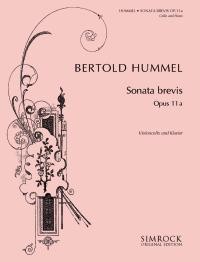Sonata brevis for Violoncello and Piano, op. 11a (1955)

I.
Allegro ![]() beginning
beginning
II. Sostenuto
III. Presto
First
Performance: June 21,1955 Cape Town (South Arfrica), Hidding Hall
Bertold
Hummel / Virginia Fortescue
Duration: 13 Minutes
Publisher: N. Simrock Hamburg-London (Boosey & Hawkes) EE 3338 / ISMN M-2211-2078-6
| I. | II. | III. |
Video: Works by Hummel on youtube
Bertold Hummel (speech on 26 January 1965 in a concert of the "Studio für Neue Musik" in Würzburg)
The concise 3-movement work gives the solo instrument ample opportunity for cantabile development. The temperamental corner movements frame a restrained "Arioso". In its formal structure it is based on classical models.
Bertold Hummel 1973At that
time we had married in South Africa - far away from all relatives - in
Swakopmund. I then gave my wife a present in the form of a sonata -
which was not as hairy as the piece they had just heard (op. 9), it was
more binding. This piece has three movements. The 1st movement in
sonata form - please note the rumba rhythm in the piano. At that time I
had heard a lot of African music and that sounds a bit pure. The 2nd
movement is European. It is an aria, an arioso. The 3rd movement is
European again and is a rondo. So have fun listening to this sonata and
remember that it was written in southern Africa.
Bertold Hummel (Conversation concert Kempten May 3, 1996)
Introduction
(Simrock EE
3338, 2006)
Bertold
Hummel wrote his Sonata brevis while extensively touring South Africa in
the spring of 1955. The dates written on the manuscripts of the individual movements
allow us to track the route he took through present-day Namibia and South Africa
in the Company of a small German music and theatre ensemble. According to these
sources, the composer and cellist, then aged 30, wrote the first movement with
its powerful subject in Windhoek while the spaciously unfolding cantilena of the
Sostenuto was written in Omaruru and the Presto of the closing movement,
in 7/4 metre, in the capital Pretoria. The Sonata brevis was premiered
in a chamber concert at Cape Town university.
Ever since its first publication
by Simrock in 1969, this lively work has been a success with performers and listeners
and will make for many future performances thanks to this carefully revised new
edition.
Martin Hummel
The Sonata Brevis was written while on a concert tour of South Africa with a trio in 1955. This work would have to wait until 1969 to be published, as Hummel did not have a publisher before this. Only the third movement, in seven, would seem to reflect the kind of cheerfulness one would associate with a young man embarking upon such an adventure with his new bride. Shorter passages in five add an improvisatory quality. The second movement, by contrast, has a beautiful but hauntingly sad melody. The closing sequence of double stops is a device the composer also uses in the closing of a Fantasia for cello solo dedicated to his son. The most intense and contrapunctal of the three movements is the first, the principal theme reappearing in close succession' in diminution and augmentation, to then yield to a more placid middle section before returning for the close.
The Cambridge Companion to the Cello; edited by Robin Stowell
Created
in 1955, this piece, like the Cello Sonata Op. 2 composed a few years earlier,
shows Bertold Hummel's familiarity with 'his' instrument which he studied with
Atis Teichmanis. The entire work is pervaded by his delight in playing and a comprehensible
melody; in particular, the brilliant final movement in 7/4 time leaves a strong
mark. The newly set and carefully revised new edition will be an interesting addition
to the repertoire of young cellists.
(News
2007 Boosey & Hawkes / Schott)